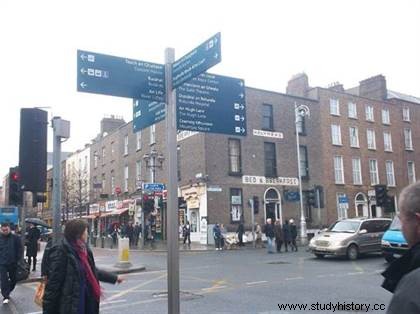 Located on the east coast of the Emerald Isle, Dublin is the capital and largest city in Ireland. The origin of its English name “Dubh Linn” means Black Tide due to the dark color of the river that separates the city. Protected by the Wicklow Mountains, Dublin extends over a plain, on either side of the Liffey estuary, at the bottom of a semi-circular bay, facing England. Formerly under Viking and British domination , the capital is full of references to the past. A very popular tourist destination, the city attracts 4.5 million visitors each year while it has only 525,000.
Located on the east coast of the Emerald Isle, Dublin is the capital and largest city in Ireland. The origin of its English name “Dubh Linn” means Black Tide due to the dark color of the river that separates the city. Protected by the Wicklow Mountains, Dublin extends over a plain, on either side of the Liffey estuary, at the bottom of a semi-circular bay, facing England. Formerly under Viking and British domination , the capital is full of references to the past. A very popular tourist destination, the city attracts 4.5 million visitors each year while it has only 525,000.
Dublin in the medieval era
Few sources evoke the history of the city at its beginnings. It would seem that certain testimonies, including the writings of Ptolemy, converge on the existence of a first Celtic colony "Atha Cliath" founded in 140 AD. At that time, Dublin was known as Eblana. The Celts would have built churches there on the banks of the Liffey, near a ford. This may explain the Gaelic origin “Atha Cliath” which means in French “the city of the ford of the claies”. We know with more certainty that much later, around 448, Saint Patrick arrived in the city to baptize converted Christians.
The Viking Age is best known to historians. In 841, the Vikings who came from Norway on their longships set up a first camp in Dublin to spend the winter. They build a garrison port on the South Banks of the river and then a Bastion at Wood Quay. The city, baptized "Dubh Linn", then became a real trading post with Europe. The Celtic and Viking peoples coexist and marriages are born between them. However, it is more than a century later that we consider the true birth of the city, in 988 with the payment of the first tax . The city therefore has a double origin:a Gaelic name "Baile Atha Cliath" in reference to the Celtic colony and "Dubh Linn" to the Viking city.
The Scandinavian hold on the capital ends with the Battle of Clontarf (1014) which marks the victory of the King of Ireland:Brian Boru. Shortly afterwards, in 1052, the last Scandinavian king of Dublin was driven out by the king of Leinster, who made this city the effective capital of the country in place of Tara. The population of Dublin, which was estimated at 4,500 inhabitants in the middle of the 11th century, increased with the arrival of the Anglo-Normans and their craftsmen-traders.
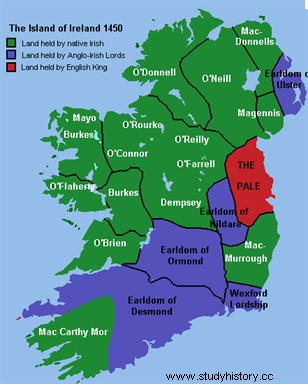
At the beginning of the 13th century, several languages were spoken in the city:French, probably a little Latin, Old English and Gaelic. It should be noted that few Irish people lived there, most being entrenched in the surrounding countryside (outside the “Pale”, towards Wicklow) over which the Anglo-Normans had limited control. Thus, between 1209 and 1316, the city fell prey to Celtic tribes, hidden in the mountains of Wicklow and who plundered it regularly. In 1348, the black plague conveyed by rats, transported in freight boats, decimated a large part of the population.
The Golden Age:Protestant Dublin
In the 17th and 18th centuries, English domination intensified and developed outside the walls of Dublin through the colonization of land. The golden age is preceded by periods of rebellions and religious wars. The rebellions fomented by Thomas Fitzgerald in 1534 against Dublin Castle were defeated by the English. New attempts to overthrow authority crushed by Elisabeth in 1602 at the battle of Kinsale, then by Olivier Cromwell in 1649. In addition, the wars of religion had repercussions on Dublin life. In 1690, the defeat of the Catholics against King William of Orange (Battle of the Boyne) resulted in the banishment of the latter from all public office and the prohibition of the right to vote. This resulted in an exodus of peasants to the city due to the confiscation of land, now owned by Protestants.
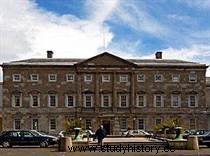
Towards emancipation
The destiny of Dublin, theater of political and cultural turmoil, is linked to that of the country wishing to emancipate itself from English domination. We cannot evoke the history of the capital without briefly resituating the context of the last two centuries.
In 1801, was formed by the initiative of the Irish parliament:the United Kingdom of Great Britain and Ireland. The Irish then hoped by this "voluntary association" to obtain within the Empire "equal laws, reciprocal affection and inseparable interests". The situation is hardly improving for the peasants who still do not own the land they cultivate. A poorly organized insurrection led by Robert Emmen against the castle ended in failure. It is with the character of O'Connell, deputy and militant that Catholics recover their rights. Its growing popularity compelled the Prime Minister of Great Britain to introduce a bill:The Catholic Emancipation Act, which will be voted in 1839. As for the peasants, they will have to wait for the agrarian reform of 1885 to become masters of their land again.
In addition to the rebellions and the desire to legally improve the status of the Irish, nationalism is also manifested by the construction of buildings intended to promote Gaelic culture. In 1904, the Abbey Theater was built in North Dublin to preserve the language. Associations such as the GAA (Gaelic Athletic Association) will offer Celtic sports such as Hurling or Gaelic football.
The 20th century was troubled by the general strikes of 1913, the civil war in 1916 which led to the occupation of public buildings by insurgents and the war of independence in 1921. The resulting treaty created six counties but caused the death of 4,000 men and the destruction of many buildings in Dublin. The courthouse and the right side of O'Connell Street gave way to the power of the shells. It was in 1949 that the government proclaimed Ireland, Republic of the Free State , with Dublin as its capital.
Ireland's integration into the European Economic Community in 1973 breathed new life into the country and the capital. Less than twenty years later, in 1992, Dublin was elected European cultural capital. The city then underwent a policy of restructuring and renovating the roads to the city center.
The many facets of Dublin, capital of Ireland
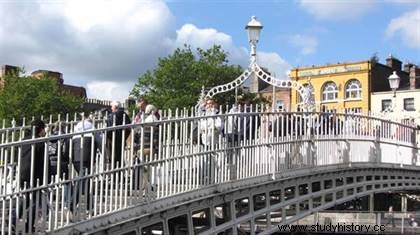 Dublin, both county and capital of the Republic of Ireland, is an energetic city, on a human scale, with an important historical and cultural heritage. What to visit in Dublin in a few days? This second part takes you around the main districts, museums and symbolic monuments passing by the Château of Dublin, Trinity College University or the old prison Kilmainham . You will find tourist routes to discover the essentials of Dublin during a short stay. Dublin is made up of several complementary and dynamic districts. North of the Liffey you will find the commercial avenue O’Connell street lined with commemorative statues, the literary surroundings as well as the docks (the quays) which run along the river. To the south are the beautiful Georgian quarter, the medieval part, the Liberties (former working class quarter) as well as the festive side of Dublin:Temple bar.
Dublin, both county and capital of the Republic of Ireland, is an energetic city, on a human scale, with an important historical and cultural heritage. What to visit in Dublin in a few days? This second part takes you around the main districts, museums and symbolic monuments passing by the Château of Dublin, Trinity College University or the old prison Kilmainham . You will find tourist routes to discover the essentials of Dublin during a short stay. Dublin is made up of several complementary and dynamic districts. North of the Liffey you will find the commercial avenue O’Connell street lined with commemorative statues, the literary surroundings as well as the docks (the quays) which run along the river. To the south are the beautiful Georgian quarter, the medieval part, the Liberties (former working class quarter) as well as the festive side of Dublin:Temple bar.
North of the Liffey, popular district with many shopping streets, developed at the end of the 17th century. It is equipped with Georgian and cultural buildings, and since the 90s with a financial space in full expansion. The district notably includes the famous post office (GPO), the Museum of Writers and the Abbey and Gate theaters often producing plays by Oscar Wilde and Samuel Beckett. During a walk on O'Connell street, you will see the Spire (the needle), a monument with a height of 120 meters very useful for finding your bearings. As you walk along the river (the docks), you will notice the large number of bridges (eleven in total) that lead to the other side of the city as well as two major administrative buildings closed to the public:Custom House and Four Courts.
To the south, the Georgian Quarter reveals a particular architecture, elegant houses, symbolizing the prosperous Dublin of the 18th century. The north of the district includes the Bank of Ireland , the heraldic museum and the oldest university in the country:Trinity College . The area around Merrion Square is famous for its colorful gates (pictured below) and is home to many national museums free located not far from each other. The beautiful parks of Merrion Square and Saint Stephen green , further south, deserve a short break. The latter, which have not always been opened 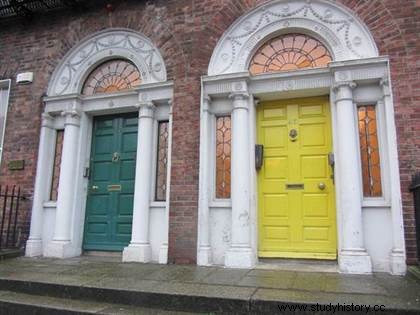 to the public, were formerly reserved for the inhabitants of the adjacent houses, until 1974 and 1880 respectively.
to the public, were formerly reserved for the inhabitants of the adjacent houses, until 1974 and 1880 respectively.
The Viking Quarter and the Liberties group together the oldest monuments of the city including the Christ Church Cathedral (1030), the St. Patrick's Cathedral (1191) and Dublin Castle (1204). The Dublinia Museum in front of Christ Church is an essential stop for all lovers of medieval history! City Hall , town hall witness to the 1916 uprising as well as the Prison-Museum of Kilmainham, symbolize the culmination of long decades of struggle for independence. The end of the Liberties, will make us change scenery with the Guinness store house , factory-museum dedicated to the beer of the same name.
Temple Bar is the name of the liveliest district of the capital but also that of the famous establishment. The many typical pubs and restaurants are an ideal gourmet stop at the end of the day. The "Brazen Head founded in 1198 is one of Dublin's oldest pubs. It is the witness of the uprising of the Irish in 1798 and an unofficial place of meeting of the latter against the British power. A little further east of Temple Bar is the Wax Museum, instructive and fun stopover. A piece of advice, it is more pleasant to reach Temple Bar by the most direct and original bridge:the Ha’penny bridge (first picture). Built in 1816, this bridge means "halfpenny" because of the toll imposed on travelers until 1919.
Suggestion of five museums and establishments to visit
You will find a selection of must-see museums. Most of them have fairly reduced opening hours (10 a.m. to 5 p.m.). It is therefore strongly recommended to start your visit in the morning.
The Museum of Writers located north of the city and open since 1991, reminds us that Ireland is not only known for the beauty of its landscapes with a Celtic soul and the production of the famous Guinness. It is a tribute to talented Irish writers. Four of them received the Nobel Prize:William Butler Yeats, George Bernard Shaw, Samuel Beckett and Seamus Heaney. The building, which is a restored Georgian mansion, stages through portraits, sculptures, drawings and rare editions, the journey of writers but also more generally the history of Irish literature.
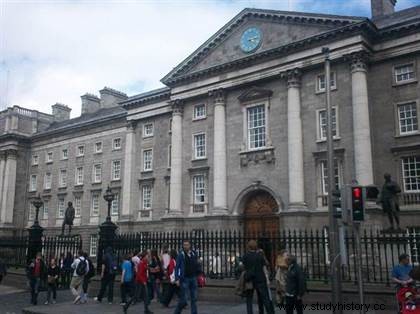 Trinity College is Ireland's oldest university and the only one open to the public. Founded in 1592 on the initiative of Queen Elisabeth 1st of England, the establishment was intended exclusively for Protestants until 1873. You cannot pass in front of its imposing facade, equipped with a clock face with an architecture similar to universities. of Oxford and Cambridge, without stopping there. The university is famous for containing in the library the most famous manuscripts including the Book of Kells . This manuscript, created around the year 800, contains magnificent illuminations as well as the Latin text of the four Gospels:Matthew, Mark, Luke and John.
Trinity College is Ireland's oldest university and the only one open to the public. Founded in 1592 on the initiative of Queen Elisabeth 1st of England, the establishment was intended exclusively for Protestants until 1873. You cannot pass in front of its imposing facade, equipped with a clock face with an architecture similar to universities. of Oxford and Cambridge, without stopping there. The university is famous for containing in the library the most famous manuscripts including the Book of Kells . This manuscript, created around the year 800, contains magnificent illuminations as well as the Latin text of the four Gospels:Matthew, Mark, Luke and John.
Let's go to the medieval quarter. The Dublinia Museum takes place in the former Synod Hall of Christ Church Cathedral and illustrates, through reconstructions, Dublin life in medieval times under the domination of the Vikings and Anglo-Normans. The reproductions of Dublin city dwellers reveal different aspects of life at the time:crafts, trade, hygiene conditions, the consequences of the plague, crimes and punishments. In the basement, you will learn more about the archaeological discoveries and the modern techniques used. If you take a combined ticket, you will be able to discover the Christ Church cathedral adjoining the museum, which you can reach by a bridge.
It is on the site of an old Viking fort that Dublin Castle was built. Built in 1204 by order of King John, it was to become the seat of British power until 1922. Of the ruins of the fortress only the Record Tower remains . The wings of the castle were devastated during the fires of 1670 and 1684. Additional towers were gradually added from the 18th century. The visit to the castle is done only with a guide.
Located to the southwest of the city, the Kilmainham Prison-Museum immerses us in the history of the country's independence through a chronological exhibition, the court of executions and the visit of the cells. Built in 1796, Kilmainham Goal served as a prison for 140 years. Many nationalist leaders have been imprisoned. These include Patrick Pearse, James Connolly, Tom Clarke who were involved in the Easter Rising and executed in 1916. The first fifty years, the conditions of detention were very precarious. You should know that there was no lighting or tiles on the windows. The prisoners received a single candle every two weeks and were fed bread, milk and oatmeal. The prison was restored between 1960 and 1986 before becoming a museum.
The Dublin Memorial Statues
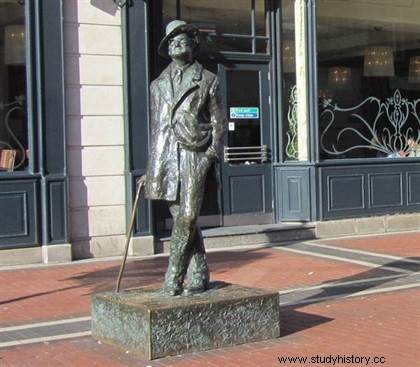 Dublin is home to around 30 commemorative statues representing writers, politicians and businessmen, journalists or more characters from folklore...
Dublin is home to around 30 commemorative statues representing writers, politicians and businessmen, journalists or more characters from folklore...
On Henry Street, opposite the Kilmore café, you will see the statue of a famous writer:James Joyce (photo opposite). He is one of the best-known novelists and poets of the 20th century, author of “The People of Dublin” and “Ulysses”. The statue was erected in 1990. To learn more, be sure to visit the “James Joyce Center », a tower-museum dedicated to the life and works of the writer.
The walk on O'connell Avenue is punctuated by prominent figures of Irish patriotism such as nationalists Daniel O'connell and Charles Stewart Parnell . Let's dwell a bit on the history of the O'Connell monument. This sculpture was erected in 1882 in honor of Daniel O'Connel, a nationalist leader to whom we owe the name of this 500-meter-long shopping avenue . This politician worked against the Act of Union and anti-Catholic legislation, The Act of Union of 1800, reinforced English domination by giving birth to the United Kingdom of Great Britain and Ireland. Having won his case thanks to the act of Catholic Emancipation (1829), Daniel O'Connell is today considered the "liberator".
The main avenue has not always welcomed fervent supporters of the Irish cause. For the record, between 1881 and 1966, stood, in place of the Spire, an embarrassing witness to the English occupation:the pillar dedicated to Admiral Nelson . This is the British vice-admiral who defeated Napoleon's fleet at Trafalgar in 1805. The column was bombarded at head level by members of the IRA (Irish Republican Army) in 1966 and then completely withdrawn.
Symbolic buildings
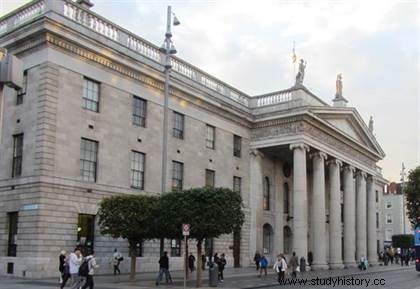
Keep heading south of the city and along the quays that you can observe Custom House and Four Courts , two administrative buildings closed to the public. Custom House , the work of architect James Gandon, is reminiscent of the Protestant golden age through the desire to beautify the city. This building required over 10 years the cost of 400,000 pounds sterling, a significant sum for the time. Despite attempts at sabotage, James Gandon and his workers managed to complete the building in 1791. Former official customs office, Custom House today includes administrative offices and is the headquarters of the Ministry of the Environment and the Ministry of Heritage. .
Four Courts, building located towards the end of the quay is the initiative of the Irish architect Thomas Cooley continued by James Gandon in 1784. The building, like the previous one, consists of a Corinthian portico. Four courts is home to the Supreme Court of the Republic of Ireland, originally built as a counterweight to British power.
These non-exhaustive tourist trails aim to familiarize you with the history of the city and its buildings during a short visit. If you have a long week, do not hesitate to visit all the national museums of the city, Saint Patrick's Cathedral, City Hall, the magnificent parks or the various libraries.
Dublin, nowadays:dynamic capital
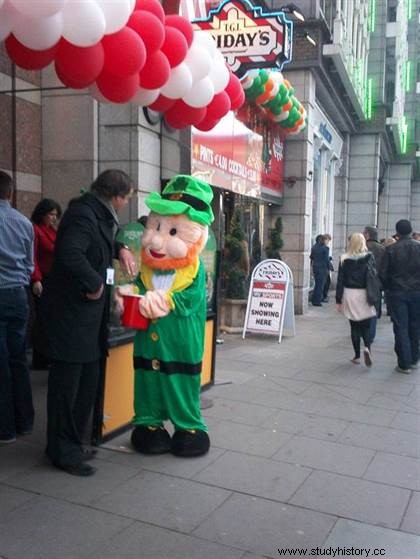
- North of the Liffey is commonly called "popular district" with many shops and a literary soul through the various theaters and the writers' museum.
- Georgian Quarter is characteristic of the golden age through Georgian architecture, includes two magnificent parks, several national museums as well as Trinity College.
- The medieval quarter and the Liberties reveal the oldest monuments including the castle and Saint-Patrick's Cathedral.
- Temple Bar is a very lively space made up of pubs, restaurants, busker musicians and storytellers.
What you need to know:
- If you are traveling to Dublin for the first time by bus , it is advisable to ask the driver for the amount to be paid (to then be inserted into a machine) which varies according to the distance and to top up because he does not give change. It may be useful to find out about your exact destination, as the names of the stops are neither specified throughout the trip nor written on the bus shelters.
- The capital being relatively small, it is advisable to walk or rent a bike to enjoy the beauty of the city. Especially since the famous shopping streets of Henry Street and Grafton Street but also those of Temple Bar are pedestrianized and lively every day of the week!
- For those in a hurry, nothing better than visiting Dublin by bus in one day thanks to the Dublin Bus Tour which will take you to the 23 most touristy places. The ticket being valid for 24 hours, do not hesitate to get off and join the bus at will on one of the 23 stops. The complete journey takes 1h30. The ticket is 16 euros for adults and 14 for students
- Do not forget that the capital is made up of a good number of free national museums and establishments for all:
- Irish Museum of Modern Art
- Municipal Gallery of Modern Art
- National Gallery of Ireland
- Natural History Museum
- National Museum of History and Archeology
- Chester Beatty Library
- Bank of Ireland State Rooms
- National Botanic Gardens
More information
- tourist office website
- Guide to Ireland
- Dublin Castle:Dublin Castle
Bibliography
- Joseph McCullough, A Pocket History of Ireland, 2010.
- Pierre Joannon, Ireland, Land of the Celts (Seamas Daly photographs), Ouest-France editions, Rennes, 1999.
- Jean Guiffan, History of Ireland, Hatier, Paris 1992.
- Elisabeth Servan-Schreiber, Bruce Winslow, The Great Guide to Ireland, Gallimard, Singapore, 1993.
